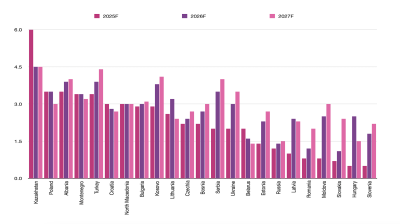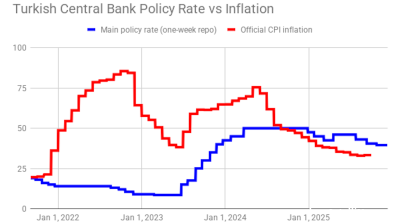The White House has slapped new sanctions on Russia and targeted the Russian Ministry of Finance ruble-denominated OFZ treasury bills for the first time, the workhorse bond that is used to fund the budget. But what do the sanctions mean in practice and how damaging are they in reality?
The short answer is: not at all. The Russian Ministry of Finance (MinFin) can finish raising all the money it intended to before the new restriction’s deadline comes into force and it also has so much money in reserves that it could simply stop issuing bonds for the next three years without causing problems.
US sanctions on Russian sovereign debt will have “no immediate impact on EMBI or GBI-EM series composition,” according to a JP Morgan note referring to the investment bank’s leading bond indices released on April 19.
“The existing index composition of ruble government bonds and $ and € Russia sovereign and quasi-sovereign bonds will remain eligible, provided these securities satisfy all other index eligibility criteria,” the bank said.
Part of the criteria includes sufficient liquidity and “accessibility.” The yield on Russia’s 10-year government ruble bond slipped a modest 15bps as a result of the sanctions last week to 6.96%, and lost 34bps during that week.
Diving into the details and it quickly becomes clear that Russian President Vladimir Putin’s fiscal fortress is complete and makes Russia impervious to US sanctions.
Primary vs secondary market trading
The first reason is the sanctions ban US investors from buying the OFZ at the Ministry of Finance’s weekly auction but there are no restrictions on US investors buying the bonds on the secondary market, nor on owning them.
The Russian state-owned banks are huge players on the OFZ market and happily sell them on to any investors that wants them. Just Russia’s two biggest state-owned banks, Sberbank and VTB Capital (VTBC), reportedly bought up half the OFZ issued at the first auction in April, after MinFin cancelled the auction a week earlier due to market volatility following the Kremlin’s build-up of military forces on Ukraine’s border.
The US has already put in place identical sanctions banning US investors from participating in the primary issue of Russia’s Eurobonds, which have had no visible effect on the bonds or their yields.
“As a case study, we highlight that last year (i.e. when US restrictions on non-RUB primary debt were already in action), Russia issued two Eurobonds denominated in EUR. Both issues became part of global bond indices and traded in the secondary market without any premium vis-à-vis their EM peers or older Russian issues. In particular, the spread of these two issues to Kazakhstan’s sovereign EUR-denominated curve is near 65bp, while the Russian $-curve trades at an 80-100bp spread to Kazakhstan,” VTBC said in a note.
International investors' share of the OFZ has been falling in the last six months, dropping from a high of 34.9% in March 2020 just before the dam of coronacrisis pandemic burst to 22.7% at the start of March. According to VTBC estimates the share has fallen below 20% since then, but this is also partly due to the large increase in issues by MinFin as a response to the same crisis, most of the which was taken up by Russian state-owned banks. the amount of OFZ outstanding was around RUB10 trillion ($131mn) in the second half of 2020 until November, when it suddenly jumped up to RUB13 trillion as the MinFin sought to raise stimulus cash, while foreign participation in the new issues remain steady and actually reduced very slightly in February due to increasing political risks.
Borrowing programme is already over
The second reason is that MinFin has already almost finished its borrowing programme for this year and could complete it before the June 14 deadline when the new restrictions come into force.
MinFin has borrowed RUB1.25 trillion YTD, according to VBTC’s estimates. This leaves just RUB1.5 trillion to place, or roughly RUB50bn per week, which is a modest volume, as the average weekly allocation was RUB77bn in 1Q21 – and has been RUB238bn per week so far in 2Q21.
“It is possible that MinFin could wrap up the borrowing plan before 14 June, as this would require only RUB190bn in weekly allocations (this week, MinFin borrowed more than that in a single auction),” VTBC said.
According to the CBR’s estimates, in March foreigners accounted for less than 10% of allocations in primary auctions, and the amount that MinFin will borrow has also recently been reduced. The domestic issuance plan for 2022-23 is RUB3.0-3.1 trillion annually, while the volumes of redemptions in 2022 are RUB1.0 trillion and RUB0.8 trillion in 2023. So the OFZ market has fallen in importance as a source of funds, as the Kremlin needs to borrow less money thanks to a recovering economy, a diversification of tax revenues away from just raw materials and the recovery of oil prices, which are now far above the breakeven price of $42 per barrel.
Fiscal fortress is ready
The third reason is that President Putin’s “fiscal fortress” is complete and even banning OFZ ownership and trading outright would not cause funding problems. The MinFin has so much money in reserves and so many other resources to tap to fund the budget, it could in theory issue no more OFZ for three years and still be able to meet its funding needs fully.
In a statement, the Russian Ministry of Finance said that it would avoid tapping the outstanding issues after 14 June in order to address and mitigate the risks of over-compliance.
In addition, MinFin stated officially that the domestic borrowing programme for this year had been cut by RUB875bn to RUB2.8 trillion. In our view, this is an important development, because at the beginning of the year, the overhang of new primary supply was the key negative factor for the medium-term outlook on OFZ.
But on top of the falling need to borrow, as part of building up this fiscal fortress, the MinFin has several alternative sources of funding. It is not only less dependent on the OFZ market for funding; it could actually stop issuing bonds entirely for three years if the need arose, according to VTBC.
“In a worst-case scenario, MinFin has additional tools to mitigate the pressure and curb volatility in the market. Firstly, MinFin has RUB5.5 trillion allocated to bank deposits and in repo operations,” says VTBC. “On top of this, the Ministry has some RUB4.0 trillion in the Treasury’s account with CBR. This is some 8.8% GDP vs. 7.5% of National Welfare Fund (NWF)’s liquid part, while the target fiscal deficit, according to the budget rule, is 0.5% GDP. Hence including future debt redemptions, MinFin theoretically could abstain from tapping the debt markets for three years at least.”
Adding these alternative sources of money up comes to RUB9.5 trillion, whereas the OFZ programme raises about RUB3 trillion a year: hence the three-year cushion.
Finally, if MinFin did want to keep the local bond market open, as it will surely want to do in even the most extreme sanctions scenario, the domestic banks have more than enough liquidity to cover the entire bond programme without the need to resort to attracting international capital. And the Russian state-owned banks will be happy to oblige, as they need the bonds to manage their liquidity in any case.
Mild market reactions
While the sanctions caught the headlines and caused a storm of commentary, the actual market participants took the new strictures in their stride.
“The debt market is now closed to Russia,” said the well-known Russia-hawk, Swedish economist and a Senior Fellow at the Atlantic Council Anders Aslund in a tweet.
However, at the next MinFin auction went ahead as planned and there was no sell-off by US investors on the secondary market, although investors appear to have been more cautious during the heighten tension in the run-up to the announcement of the new sanctions.
“Based on NSD data, we estimate that international holdings have declined by some RUB300bn YTD to RUB2.8 trillion, while the foreign ownership share decreased to 19.5% (-3pp). In our view, this was already a sufficient adjustment of international positioning, and we expect foreign flows to be balanced in coming weeks, if geopolitics remain calm,” VTBC says.
The OFZ market remains very attractive to bond traders and US institutional investors. While the emerging market bond markets have suffered a shock recently as yields on US T-bills have started climbing recently – yields have gone from next to zero to around 1.6%, now sparking speculation over a repeat of the 2013 “taper tantrum” – these yields are still nowhere near the circa 5% they would need to be to cause a massive rotation out of high-paying Russian bonds, back into US securities, as happened in 2008 contributing to the global financial crisis then.
The last time there was a sell-off on the OFZ market was in 2018, when the Eurobond restrictions were imposed. Then foreign investors sold some RUB500bn worth of OFZ afraid they would be banned from the market completely and yields shot up 200bp to around 9%. However, when the details of the sanctions were revealed in August 2019, as the chart shows, investors quickly got back into the market and started buying again. Indeed, they had already started buying in the months before August as it became clear an outright ownership ban was not on the cards.
This time round and there has been no noticeable sell off of OFZ by non-residents yet, although the rate of buying has slowed as some investors at the fringes have been discouraged from buying, VTBC said in a note.
US investors not that important
Another aspect of the sanctions is that while the number of US investors in the OFZ market is significant, it is not overwhelming. The departure of US investors if stringent bans were introduced would be an irritation but not a disaster.
VTBC estimates that US investors hold between 30% and 40% of the total RUB3.14 trillion ($41.4bn) outstanding OFZ as of March 1.
“Therefore, if 100% of US investors – who are presumably more sensitive to US sanctions – close their positions, this might result in RUB0.8-1.1tn of future outflows,” VTBC said.
If you add into that the global index tracking funds that are also exposed to the sanctions on US ownership of OFZ then the outflows could be bigger. VTBC estimates that these funds probably hold another 7% of OFZ, which is equivalent to RUB0.5 trillion of bonds, which would mean a total outflow of RUB1.6 trillion – or about half of the non-resident holding.
Given the total outstanding OFZ were RUB13.8 trillion as of the start of March, if all these non-residents left the market overnight that would be a loss of 11.5% of the total. If these investors go that would sting, but not more than that.
What next?
What happens next? The US is due to announce more sanctions in June that are part of the automatically mandated sanctions roll-out after it invoked the Chemical and Biological Weapons Control and Warfare Elimination Act of 1991 (CBW) sanctions on the use of chemical weapons as the framework for the sanctions it brought on nine people associated with using the Novichok nerve agent on the jailed anti-corruption activist and opposition politician Alexei Navalny in February.
Some have speculated that this next round of sanctions could include sanctions on secondary market trading of OFZ, but that seems highly unlikely at this point.
It should be made clear the difference between primary and secondary market sanctions is enormous. As the secondary market in OFZ is so big and so liquid the ban presents little obstacle to US investors that want to buy them. However, a ban on secondary market trading or ownership would force US investors to dump approximately $10bn worth of bonds almost overnight. And as the ban also precludes their usual counterparties from buying them, the only people to sell to would be Russian banks or the MinFin. Asian investors, including Chinese investors, already said that they don't want to expose themselves to US retaliation following the 2019 Eurobonds sanctions, and the Asian market is much smaller and would struggle to absorb such a large amount of bonds in any case.
The losses incurred by US investors from a secondary ban would be substantial. The US banking lobby is big and powerful and would actively work against secondary market sanctions.
Moreover, as bne IntelliNews has speculated elsewhere, the very mildness of the OFZ sanctions strongly suggests that US President Joe Biden wants to keep the door open to a possible summit with his counterpart, Vladimir Putin. In the days after the sanctions were announced the Kremlin complained loudly and responded with its own set of sanctions and punishments, but pointedly it also said it remains open to a summit. It seems that Biden’s sanctions were finely judged and “not too hot, but not too cold” either.
Two months is not enough time to even organise a summit, let alone extract some positive results from a successful summit. And Russia would be very unlikely to go into a summit with the threat of the June sanctions hanging over it. The Kremlin will almost certainly wait until June is passed before agreeing to meet with Biden and will expect Biden to offer up another round of mild sanctions before it is willing to start a parley.
Features

BEYOND THE BOSPORUS: Espionage claims thrown at Imamoglu mean relief at dismissal of CHP court case is short-lived
Wife of Erdogan opponent mocks regime, saying it is also alleged that her husband “set Rome on fire”. Demands investigation.

Turkmenistan’s TAPI gas pipeline takes off
Turkmenistan's 1,800km TAPI gas pipeline breaks ground after 30 years with first 14km completed into Afghanistan, aiming to deliver 33bcm annually to Pakistan and India by 2027 despite geopolitical hurdles.

Looking back: Prabowo’s first year of populism, growth, and the pursuit of sovereignty
His administration, which began with a promise of pragmatic reform and continuity, has in recent months leaned heavily on populist and interventionist economic policies.

Emerging Europe’s growth holds up but risks loom, says wiiw
Fiscal fragility, weakening industrial demand from Germany, and the prolonged fallout from Russia’s war in Ukraine threaten to undermine growth momentum in parts of the region.


